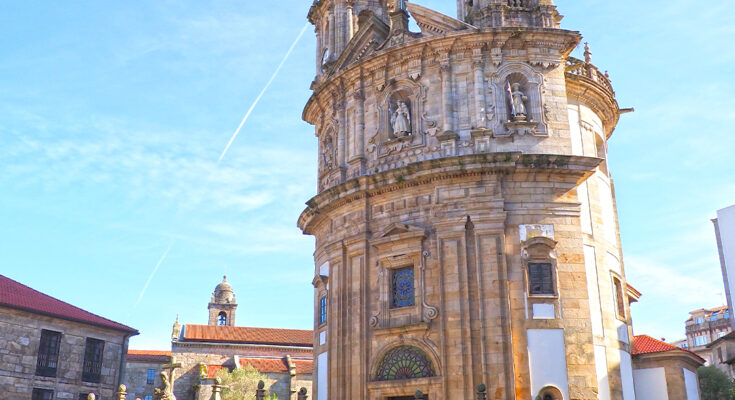Pontevedra is a reference in terms of a healthy city, make it a very comfortable destination to live. And, of course, to visit. Here we show at least five things that we cannot miss.
A Peregrina Church, as its name suggests, has a lot to do with the Camino de Santiago. It is dedicated to the Pilgrim Virgin, who was the one who guided the walkers who came from Baiona to Santiago. She is the patron saint of Pontevedra and the Portuguese Way.
It was built in the 18th century, halfway between the Baroque and the Neoclassical. The first thing that catches our attention is its half-rounded façade, why is it? As it turns out that the plant is inspired by a scallop shell, this church could not be more pilgrimage! All the details are related to the pilgrimage. Even the baptismal font is a giant shell donated by Méndez Núñez, who brought it back from one of his exotic trips.
The main façade, by Antón Souto, has an image of the Virgin from the 19th century on top. The main altarpiece is neoclassical, made by Melchor de Prado, with variations contributed by Manuel de Prado and Juan Pernas Gambino. The entrance to the church is preceded by a fountain, in which we can fill our shell and have a drink.

Another symbol of the city is the Alameda: the urban park of Pontevedra par excellence. It was designed at the end of the 19th century by the architect Alejandro Sesmero. as part of the expansion works of the city outside the walls. In the past it was the Campo da Verdade and das Rodas, and here the fishing instruments were made. With the arrival of the Dominican loos, the space was transformed into a place for a walk.
It is a wooded oval surface. On the western side there is a viewpoint with stairs. On the outer wall, the mosaics by Carlos Sobrino stand out, with costumbrista and traditional scenes: the Plaza de la Leña, the hermitage of Santa María de A Lanzada, hórreos de Combarro… On the promenade there is also a monument to the heroes of Ponte Sampaio and a music box.

If we cross the Plaza de España from the Alameda and walk along the Avenida de Santa María, where will we end up? In the Royal Basilica of Santa María A Maior, of course. It is a Gothic building, the most important example of Elizabethan Gothic in Galicia, with influences from the Portuguese Manueline. The construction of the temple, in the 16th century, was promoted by the Dizzying Guild, very powerful at the time, due to the maritime and commercial boom of the city.
We access the main façade, to the west, through a steep staircase. The façade looks like a Plateresque altarpiece, the work of Cornielis de Holanda and Juan Noble, probably from 1541. The relief of the dormition of the Virgin stands out.
The façade on the south side faces the Plaza de Alonso Fonseca. A large stone cross and the Good Trip Christ, protector of devout travelers, stand out. The tower leads to a museum and a viewpoint with views of the old town and the estuary. Curiously, another view of the city is engraved on the stone itself on the façade.

By the way, the old Mayot altarpiece of the basilica is on display in the Museum of Pontevedra. Actually, this museum houses a good number of works of art. It was born in 1927 with the mission of conserving, exhibiting, researching and disseminating Galician heritage, and it has grown so much that it now occupies six physical locations, all in the historical complex of the city. Namely: the Castro Monteagudo building, in the Plaza de la Leña, in the process of being restored; the ruins of San Domingos, one of the first to be declared a national monument, in 1895, which in 1937 was incorporated into the museum; the García Flórez building, today also under rehabilitation; the Fernández López building, administrative center of the museum and headquarters of the archive, library and research room; the Sarmieto building, rehabilitated in the 20th and 21st centuries, and dedicated to Prehistory, ancient history and ceramics primarily, and the Castelao building, entirely newly built, dedicated to Galician history and art from the early Middle Ages to today.
As we can see, Pontevedra is a city with a lot of art: it has a monumental historic center, a museum to tip your hat off to, the only fine arts college in Galicia and even… an artistic island! It is the Illa das Esculturas (Sculpture Island), also known as Illa do Covo or Illa da Xunqueira. It is in an area of Lérez of great natural value, which is part of the Natura 2000 Network. It has everything: bike lanes, walkways, bridges, fountains and even a playground.
The island has become an open-air museum since it houses sculptures by twelve great international contemporary artists. The proposal, which came from the historians Rosa Olivares and Antón Castro, implied making a work in granite, which had to do with Galicia, and specifically for the island. Thus, for example, Robert Morris’s labyrinth is inspired by the Mogor petroglyphs, Dan Graham’s pyramid takes us into the shadows and reflections of the river, Jenny Holzer invites us to reflect on its banks with engraved phrases, Leiro proposes the extension of the home inside the river, with an armchair and a shelf with floating cheeses…





